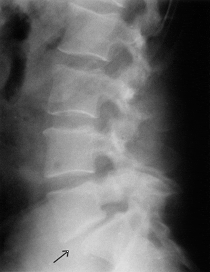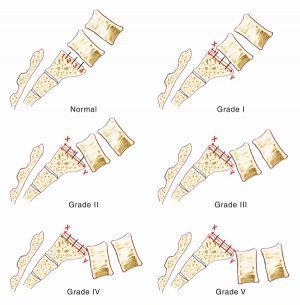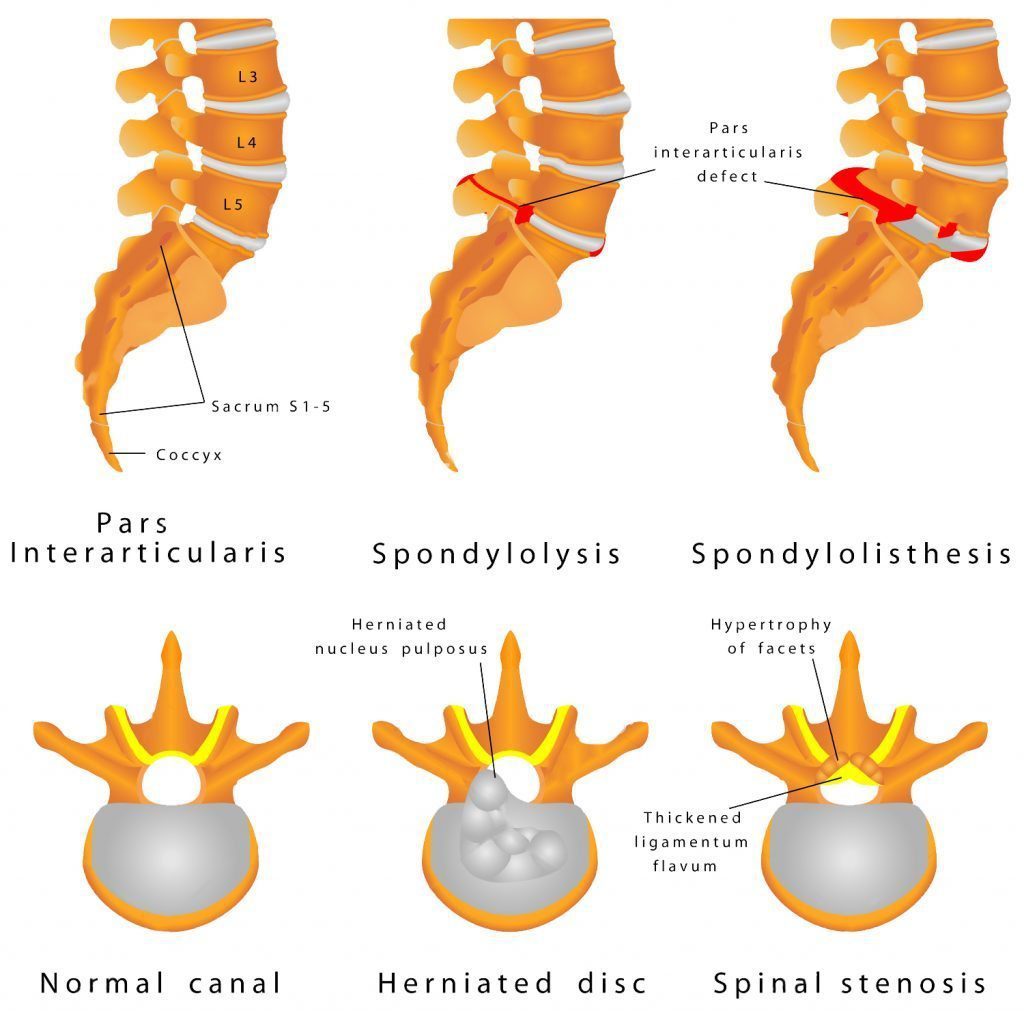El Paso, TX. Chiropractor Dr. Alex Jimenez discusses spondylolisthesis or a forward slip of a vertebra.
The word spondylolisthesis derives from two parts: spondylo which means spine, and listhesis which means slippage. Spondylolisthesis generally happens towards the bottom of your spine in the lumbar area.

This x-ray reveals spondylolisthesis in the lumbar spine. Look at where the arrow is pointing: you are able to note that the vertebra above the arrow has slipped out over the vertebra below it.
Table of Contents
Spondylolisthesis Grades
Spondylolisthesis may be described based on its level of severity. One description grades that are commonly used spondylolisthesis, with grade 1 being least advanced, and grade 5 being advanced. By quantifying just how much of a vertebral body has slipped forward on the body beneath it, the spondylolisthesis is graded.
- Grade 1 25% of vertebral body has stolen forward
- Grade 2 50%
- Grade 3 75%
- Grade 4 100%
- Class 5 Vertebral body completely fallen off (i.e.,spondyloptosis)

How People Get Spondylolisthesis?
Around 5%- 6% of men, and 2% -3% of females have a spondylolisthesis.
It becomes clear more frequently in individuals who are involved with very physical activities like football, gymnastics, or weightlifting.
Males are far more likely than females to develop symptoms in the illness, chiefly because of their engaging in more physical tasks.
Though some kids under the age of five could be predisposed towards having a spondylolisthesis, or may indeed have a spondylolisthesis that is undetected, it’s uncommon that such young kids are diagnosed with spondylolisthesis. The increased physical activities of adolescence and adulthood, combined with the wear-and-tear of daily life, result in spondylolisthesis being most common among grownups and teenagers.

Types Of Spondylolisthesis
Different types of spondylolisthesis may be caused in a various ways. Some examples are:
Developmental Spondylolisthesis:
This type of spondylolisthesis may develop during childhood, or may exist at birth, but typically isn’t detected until later in childhood or even in adult life.
Acquired Spondylolisthesis:
Acquired spondylolisthesis could be caused in 1 of 2 manners:
- With all the day-to-day anxieties which are put on a back, such as taking heavy items and physical sports, the spine may wear out (ie, degenerate). As the links involving the vertebrae weaken, this can result in spondylolisthesis.
- A single or recurrent force being put on the spine may cause spondylolisthesis; for example, the impact of falling off the standard impact to the spine, or a ladder and landing on your feet put by offensive linemen playing football.
What Symptoms Might I See ?
A lot of people having a spondylolisthesis will have no symptoms and will only become aware of the issue when it is revealed on an x-ray for a difficulty that is different. Nevertheless, you will find numerous symptoms that commonly accompany spondylolisthesis:
- Pain in the low back, especially after exercise
- Increased lordosis (ie, swayback).
- Pain and/or weakness in one or both thighs or legs
- Reduced ability to control bowel and bladder functions
- Tight hamstring musculature
- In cases of spondylolisthesis that is complex changes may happen in the way in which individuals walk and stand; for example, development of a waddling style of walking. This causes the abdomen to protrude further, as a result of the lowbackcurving forward more. The torso (chest, etc.) may seem shorter; and muscle spasms in the lowback may occur.

Post Disclaimer
Professional Scope of Practice *
The information on this blog site is not intended to replace a one-on-one relationship with a qualified healthcare professional or licensed physician and is not medical advice. We encourage you to make healthcare decisions based on your research and partnership with a qualified healthcare professional.
Blog Information & Scope Discussions
Welcome to El Paso's Premier Wellness and Injury Care Clinic & Wellness Blog, where Dr. Alex Jimenez, DC, FNP-C, a board-certified Family Practice Nurse Practitioner (FNP-BC) and Chiropractor (DC), presents insights on how our team is dedicated to holistic healing and personalized care. Our practice aligns with evidence-based treatment protocols inspired by integrative medicine principles, similar to those found on this site and our family practice-based chiromed.com site, focusing on restoring health naturally for patients of all ages.
Our areas of chiropractic practice include Wellness & Nutrition, Chronic Pain, Personal Injury, Auto Accident Care, Work Injuries, Back Injury, Low Back Pain, Neck Pain, Migraine Headaches, Sports Injuries, Severe Sciatica, Scoliosis, Complex Herniated Discs, Fibromyalgia, Chronic Pain, Complex Injuries, Stress Management, Functional Medicine Treatments, and in-scope care protocols.
Our information scope is limited to chiropractic, musculoskeletal, physical medicine, wellness, contributing etiological viscerosomatic disturbances within clinical presentations, associated somato-visceral reflex clinical dynamics, subluxation complexes, sensitive health issues, and functional medicine articles, topics, and discussions.
We provide and present clinical collaboration with specialists from various disciplines. Each specialist is governed by their professional scope of practice and their jurisdiction of licensure. We use functional health & wellness protocols to treat and support care for the injuries or disorders of the musculoskeletal system.
Our videos, posts, topics, subjects, and insights cover clinical matters and issues that relate to and directly or indirectly support our clinical scope of practice.*
Our office has made a reasonable effort to provide supportive citations and has identified relevant research studies that support our posts. We provide copies of supporting research studies available to regulatory boards and the public upon request.
We understand that we cover matters that require an additional explanation of how they may assist in a particular care plan or treatment protocol; therefore, to discuss the subject matter above further, please feel free to ask Dr. Alex Jimenez, DC, APRN, FNP-BC, or contact us at 915-850-0900.
We are here to help you and your family.
Blessings
Dr. Alex Jimenez DC, MSACP, APRN, FNP-BC*, CCST, IFMCP, CFMP, ATN
email: coach@elpasofunctionalmedicine.com
Licensed as a Doctor of Chiropractic (DC) in Texas & New Mexico*
Texas DC License # TX5807
New Mexico DC License # NM-DC2182
Licensed as a Registered Nurse (RN*) in Texas & Multistate
Texas RN License # 1191402
ANCC FNP-BC: Board Certified Nurse Practitioner*
Compact Status: Multi-State License: Authorized to Practice in 40 States*
Graduate with Honors: ICHS: MSN-FNP (Family Nurse Practitioner Program)
Degree Granted. Master's in Family Practice MSN Diploma (Cum Laude)
Dr. Alex Jimenez, DC, APRN, FNP-BC*, CFMP, IFMCP, ATN, CCST
My Digital Business Card


